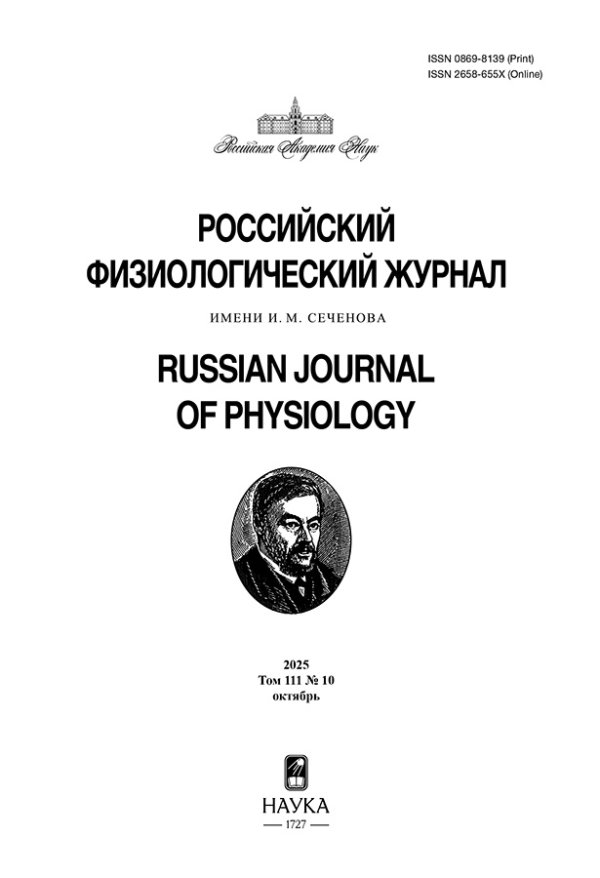Влияние нокаута рецептора TAAR1 на характеристики поведения мышей в тестах, оценивающих уровень тревожности и депрессивно-подобное поведение
- Авторы: Виноградова Е.П.1, Беляков Д.В.1, Козырева А.В.1, Орлова Д.Н.1, Александров А.А.1
-
Учреждения:
- Санкт-Петербургский государственный университет
- Выпуск: Том 111, № 4 (2025)
- Страницы: 614-624
- Раздел: ЭКСПЕРИМЕНТАЛЬНЫЕ СТАТЬИ
- URL: https://gynecology.orscience.ru/0869-8139/article/view/680901
- DOI: https://doi.org/10.31857/S0869813925040042
- EDN: https://elibrary.ru/UFEPQR
- ID: 680901
Цитировать
Полный текст
Аннотация
Целью данного исследования было изучение функциональной роли рецептора TAAR1, одного из представителей рецепторов следовых аминов (trace amine–associated receptors, TAARs). Изучалось поведение мышей нокаутов TAAR1-KO и мышей дикого типа WT в тестах, отражающих уровень тревожности и депрессивно-подобные состояния. В тесте подавления пищевого поведения в новой обстановке (Novelty-Suppressed Feeding Test) было показано, что у мышей TAAR1-КО среднее время подхода к приманке существенно короче, чем у мышей WT. По всем остальным параметрам пищевого поведения (латентный период до начала еды, длительность потребления пищи, количество подходов к приманке, количество приемов пищи) не было выявлено статистически значимых различий. В тесте подвешивания за хвост (Tail suspension test) и тесте принудительного плавания Порсолта латентный период первой иммобилизации был достоверно выше у мышей TAAR1-КО. У мышей TAAR1-KO в тесте Порсолта была обнаружена меньшая длительность иммобилизации по сравнению с мышами WT.
Полный текст
Об авторах
Е. П. Виноградова
Санкт-Петербургский государственный университет
Автор, ответственный за переписку.
Email: e.vinogradova@spbu.ru
Россия, Санкт-Петербург
Д. В. Беляков
Санкт-Петербургский государственный университет
Email: e.vinogradova@spbu.ru
Россия, Санкт-Петербург
А. В. Козырева
Санкт-Петербургский государственный университет
Email: e.vinogradova@spbu.ru
Россия, Санкт-Петербург
Д. Н. Орлова
Санкт-Петербургский государственный университет
Email: e.vinogradova@spbu.ru
Россия, Санкт-Петербург
А. А. Александров
Санкт-Петербургский государственный университет
Email: e.vinogradova@spbu.ru
Россия, Санкт-Петербург
Список литературы
- Berry MD, Gainetdinov RR, Hoener MC, Shahid M (2017) Pharmacology of human trace amine-associated receptors: Тherapeutic opportunities and challenges. Pharmacol Ther 180: 161–180. https://doi.org/10.1016/j.pharmthera.2017.07.002
- Gainetdinov RR, Hoener MC, Berry MD Trace Amines and Their Receptors (2018) Pharmacol Rev 70(3): 549–620. https://doi.org/10.1124/pr.117.015305
- Rutigliano G, Accorroni A, Zucchi R (2018) The case for TAAR1 as a modulator of central nervous system function. Front Pharmacol 8: 987. https://doi.org/10.3389/fphar.2017.00987
- Pei Y, Asif-Malik A, Canales JJ (2016) Trace amines and the trace amine-associated receptor 1: Pharmacology, neurochemistry, and clinical implications. Front Neurosci 10: 148. https://doi.org/10.3389/fnins.2016.00148
- Berry MD (2007) The potential of trace amines and their receptors for treating neurological and psychiatric diseases. Rev Recent Clin Trials 2(1): 3–19. https://doi.org/10.2174/157488707779318107
- Lindemann L, Hoener MC (2005) A renaissance in trace amines inspired by a novel GPCR family. Trends Pharmacol Sci 26: 274-281. https://doi.org/10.1016/j.tips.2005.03.007
- Revel FG, Moreau JL, Pouzet B, Mory R, Bradaia A, Buchy D, Metzler V, Chaboz S, Groebke Zbinden K, Galley G, Norcross RD, Tuerck D, Bruns A, Morairty SR, Kilduff TS, Wallace TL, Risterucci C, Wettstein JG, Hoener MC (2013) A new perspective for schizophrenia: TAAR1 agonists reveal antipsychotic- and antidepressant-like activity, improve cognition and control bodyweight. Mol Psychiatry 18: 543–556. https://doi.org/10.1038/mp.2012.57
- Leo D, Targa G, Espinoza S, Villers A, Gainetdinov RR, Ris L (2022) Trace Amine Associate Receptor 1 (TAAR1) as a New Target for the Treatment of Cognitive Dysfunction in Alzheimer's Disease. Int J Mol Sci 23(14): 7811. https://doi.org/10.3390/ijms23147811
- Correll CU, Koblan KS, Hopkins SC, Li Y., Heather Dworak, Goldman R., Loebel A (2021) Safety and effectiveness of ulotaront (SEP-363856) in schizophrenia: Results of a 6-month, open-label extension study. NPJ Schizophr 7(1): 63. https://doi.org/10.1038/s41537-021-00190-z
- Koblan KS, Kent J, Hopkins SC, Krystal JH, Cheng H, Goldman R, Loebel A (2020) A Non-D2-Receptor-Binding Drug for the Treatment of Schizophrenia. N Engl J Med 382(16): 1497–1506. https://doi.org/10.1056/NEJMoa1911772
- Полякова НВ, Александров АЮ, Князева ВМ, Виноградова ЕП, Дмитриева ЕС, Станкевич ЛН, Александров АА (2023) Действие агониста TAAR1 RO 5263397 на дискинезию, вызываемую инъекцией α-NETA. Интеграт физиол 3: 346–355. [Polyakova NV, Aleksandrov AYu, Knyazeva VM, Vinogradova EP, Dmitrieva ES, Stankevich LN, Aleksandrov AA (2023) TAAR1 agonist reduces α-NETA induced dyskinesia. Integrat Physiol 3: 346–355. (In Russ)]. https://doi.org/10.33910/2687-1270-2023-4-3-346-355
- Sotnikova TD, Caron MG, Gainetdinov RR (2009) Trace amine-associated receptors as emerging therapeutic targets. Mol Pharmacol 76(2): 229–235. https://doi.org/10.1124/mol.109.055970
- Revel FG, Moreau JL, Gainetdinov RR, Ferragud A, Velázquez-Sánchez C, Sotnikova TD, Morairty SR, Harmeier A, Zbinden GK, Norcross RD, Bradaia A, Kilduff TS, Biemans B, Pouzet B, Caron MG, Canales JJ, Wallace TL, Wettstein JG, Hoener MC (2012) Trace amine-associated receptor 1 partial agonism reveals novel paradigm for neuropsychiatric therapeutics. Biol Psychiatry 72: 934–942. https://doi.org/10.1016/j.biopsych.2012.05.014
- Revel FG, Moreau JL, Gainetdinov RR, Bradaia A, Sotnikova TD, Mory R, Durkin S, Zbinden KG, Norcross R, Meyer CA, Metzler V, Chaboz S, Ozmen L, Trube G, Pouzet B, Bettler B, Caron MG, Wettstein JG, Hoener MC (2011) TAAR1 activation modulates monoaminergic neurotransmission, preventing hyperdopaminergic and hypoglutamatergic activity. Proc Natl Acad Sci U S A 108(20): 8485–8490. https://doi.org/10.1073/pnas.1103029108
- Wolinsky TD, Swanson CJ, Smith KE, Zhong H, Borowsky B, Seeman P, Branchek T, Gerald CP (2007) The Trace Amine 1 receptor knockout mouse: An animal model with relevance to schizophrenia. Genes Brain Behav 6(7): 628–639. https://doi.org/10.1111/j.1601-183X.2006.00292.x
- Zhukov IS, Karpova IV, Krotova NA, Tissen IY, Demin KA, Shabanov PD, Budygin EA, Kalueff AV, Gainetdinov RR (2022) Enhanced Aggression, Reduced Self-Grooming Behavior and Altered 5-HT Regulation in the Frontal Cortex in Mice Lacking Trace Amine-Associated Receptor 1 (TAAR1). Int J Mol Sci 23(22): 14066. https://doi.org/10.3390/ijms232214066
- Vinogradova EP, Simon YA, Aleksandrov AY, Knyazeva VM, Stankevich L N, Kozyreva AV, Aleksandrov AA (2023) Mice lacking TAAR1 show no early behavioral response to acute restraint stress. J Evol Biochem Physiol 59(6): 2141–2152. https://doi.org/10.1134/S0022093023060194
- Симон ЮА, Виноградова ЕП, Козырева АВ, Александров АЮ, Князева ВМ, Станкевич ЛН, Маркина АА, Иоффе ВС, Александров АА (2024) Влияние нокаута гена TAAR1 на характеристики поведения мышей в тесте Порсолта и в приподнятом крестообразном лабиринте. Вестн Томск гос универ Биология 68. [Simon YA, Vinogradova EP, Kozyreva AV, Aleksandrov AY, Knyazeva VM, Stankevich LN, Markina AA, Ioffe VS, Aleksandrov AA (2024) Effect of TAAR1 knockout on behavioural characteristics of mice in the forced swim test and in the elevated plus maze test. Tomsk State Univer J Biol 68. (In Russ)].
- Zhukov IS, Kubarskaya LG, Tissen IY, Kozlova AA, Dagayev SG, Kashuro VA, Vlasova OL, Sinitca E, Karpova IV, Gainetdinov RR (2020) Minimal Age-Related Alterations in Behavioral and Hematological Parameters in Trace Amine-Associated Receptor 1 (TAAR1) Knockout Mice. Cell Mol Neurobiol 40(2): 273–282. https://doi.org/10.1007/s10571-019-00721-4
- Aleksandrov АА, Dmitrieva ES, Knyazeva VM, Simon YA, Polyakova NV, Stankevich LN, Aleksandrov AY (2022) Sensory Gating in TAAR1 Knockout Mice. J Evol Biochem Physiol 58: 979–985. https://doi.org/10.1134/S0022093022040044
- Cryan JF, Sweeney FF (2011) The age of anxiety: Role of animal models of anxiolytic action in drug discovery. Br J Pharmacol 164: 1129–1161.
- doi: 10.1111/j.1476-5381.2011.01362.x
- Bodnoff SR, Suranyi-Cadotte В, Aitken DH, Quirion R, Meaney MJ (1988) The effects of chronic antidepressant treatment in an animal model of anxiety. Psychopharmacology (Berl) 95(3): 298–302. https://doi.org/10.1007/BF00181937
- Bessa JM, Mesquita AR, Oliveira M, Migue J, Pêgo JM, Cerqueira JJ, Palha JA, Almeida OFX, Sousa N (2009) A trans-dimensional approach to the behavioral aspects of depression. Front Behav Neurosci 3: 1. https://doi.org/ 10.3389/neuro.08.001.2009
- Francois М, Delgado IC, Shargorodsky N, Leu CS, Zeltser L (2022) Assessing the effects of stress on feeding behaviors in laboratory mice. Neuroscience 11: e70271. https://doi.org/10.7554/eLife.70271
- Dulawa SC, Hen R (2005) Recent advances in animal models of chronic antidepressant effects: The novelty-induced hypophagia test. Neurosci Biobehav Rev 29(4–5): 771–783. https://doi.org/10.1016/j.neubiorev.2005.03.017
- Can A, Dao DT, Arad M, Terrillion CE, Piantadosi SC, Gould TD (2012) The mouse forced swim test. J Vis Exp 59: e3638. https://doi.org/10.3791/3638
- Yankelevitch-Yahav R, Franko M, Huly A, Doron R (2015) The Forced Swim Test as a Model of Depressive-like Behavior. J Vis Exp 97: e52587. https://doi.org/10.3791/52587
- Bodnoff SR, Suranyi-Cadotte B, Quirion R, Meaney MJ (1989) A comparison of the effects of diazepam versus several typical and atypical anti-depressant drugs in an animal model of anxiety. Psychopharmacology (Berl) 97(2): 277–279. https://doi.org/10.1007/BF00442264
- Kulkarni SK, Singh K, Bishnoi M (2007) Elevated zero maze: A paradigm to evaluate antianxiety effects of drugs. Methods Find Exp Clin Pharmacol 29: 343–348. https://doi.org/10.1358/mf.2007.29.5.1117557.
- Tucker LB, McCabe JT (2017) Behavior of Male and Female C57BL/6J Mice Is More Consistent with Repeated Trials in the Elevated Zero Maze than in the Elevated Plus Maze. Front Behav Neurosci 11: 13. https://doi.org/10.3389/fnbeh.2017.00013
- Rygula R, Abumaria N, Flugge G, Fuchs E, Ruther E, Havemann-Reinecke U (2005) Anhedonia and motivational deficits in rats: Impact of chronic social stress. Behav Brain Res 162: 127–134. https://doi.org/10.1016/j.bbr.2005.03.009
- Overstreet DH, Friedman E, Mathé AA, Yadid G (2005) The Flinders Sensitive Line rat: A selectively bred putative animal model of depression. Neurosci Biobehav Rev 29: 739–759. https://doi.org/10.1016/j.neubiorev.2005.03.015
- Koek W, Sandoval TL, Daws LC (2018) Effects of the antidepressants desipramine and fluvoxamine on latency to immobility and duration of immobility in the forced swim test in adult male C57BL/6J mice. Behav Pharmacol 29(5): 453–456. https://doi.org/10.1097/FBP.0000000000000371
- Cryan JF, Mombereau C, Vassout A (2005) The tail suspension test as a model for assessing antidepressant activity: Review of pharmacological and genetic studies in mice. Neurosci Biobehav Rev 29: 571–625. https://doi.org/10.1016/j.neubiorev.2005.03.009
- Steru L, Chermat R, Thierry B, Simon P (1985) The tail suspension test: A new method for screening antidepressant drugs. Psychopharmacology 85: 367–370. https://doi.org/10.1007/BF00428203
- Liu J, Hester K, Pope C (2021) Dose- and time-related effects of acute diisopropylfluorophosphate intoxication on forced swim behavior and sucrose preference in rats. Neurotoxicology 82: 82–88. https://doi.org/10.1016/j.neuro.2020.11.007
- Armario A, Gavalda A, Marti J (1995) Comparison of the behavioural and endocrine to forced swimming stress in five inbred strains of rats. Psychoneuroendocrinology 20: 879–890. https://doi.org/10.1016/0306-4530(95)00018-6
- Swiergiel AH, Leskov IL, Dunn AJ (2008) Effects of chronic and acute stressors and CRF on depression-like behavior in mice. Behav Brain Res 186(1): 32–40. https://doi.org/10.1016/j.bbr.2007.07.018
- Tang J, Yu W, Chen S, Gao Z, Xiao B (2018) Microglia Polarization and Endoplasmic Reticulum Stress in Chronic Social Defeat Stress Induced Depression, Mouse. Neurochem Res 43: 985–994. https://doi.org/10.1007/s11064-018-2504-0
- Leschik J, Gentile A, Cicek C, P´eron S, Tevosian M, Beer A, Radyushkin K, Bludau A, Ebner K, Neumann I, Singewald N, Berninger B, Lessmann V, Lutz B (2022) Brain-derived neurotrophic factor expression in serotonergic neurons improves stress resilience and promotes adult hippocampal neurogenesis. Progr Neurobiol 217: 102333. https://doi.org/10.1016/j.pneurobio.2022.102333
- Commons KG, Cholanians AB, Babb JA, Ehlinger DG (2017) The Rodent Forced Swim Test Measures Stress-Coping Strategy, Not Depression-like Behavior. ACS Chem Neurosci 8: 955–960. https://doi.org/10.1021/acschemneuro.7b00042
- de Kloet ER, Molendijk ML (2016) Coping with the Forced Swim Stressor: Towards Understanding an Adaptive Mechanism. Neural Plasticity 2016: 6503162. https://doi.org/10.1155/2016/6503162
- Муртазина РЗ, Гайнетдинов РР (2019) Трансгенные животные в экспериментальной фармакологии: фокус на рецепторах следовых аминов. Рос физиол журн им ИМ Сеченова 105(11): 1373–1380. [Murtazina RZ, Gainetdinov RR (2019) Transgenic Animal Models in Experimental Pharmacology: Focus on Trace Amine-Associated Receptors. Russ J Physiol 105(11): 1373–1380. (In Russ)]. https://doi.org/10.1134/S0869813919110098
- European Convention for the Protection of Vertebrate Animals Used for Experimentation and other Scientific Purposes (1986).
Дополнительные файлы









